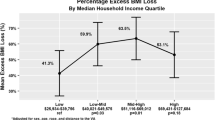Abstract
Background
Bariatric surgery has emerged as an effective and safe treatment for severe obesity and utilization rates have increased dramatically. In private health care settings, low socioeconomic status is associated with a reduced likelihood of undergoing a bariatric procedure. Whether this relationship is also present in a universally accessible, publicly funded health care system is not currently known.
Methods
A retrospective analysis of the Edmonton Weight Wise obesity program clinical registry was conducted. Patients who were unemployed, on long-term disability or receiving social assistance were classified as “low income” status. The remaining patients were categorized as “regular income” status. Multivariable logistic regression analysis was used to examine the association between low income status and approval for surgery within 1 year of program entry.
Results
Thirty-three (7%) of 419 patients were ineligible for surgery or excluded because of missing income status data. Of the remaining 386 patients, 72 (19%) were of low income status and 89 (23%) were approved for surgery. Low income patients were older, heavier, and had greater comorbidity. Compared to patients of regular income status, those with low income status were less likely to be approved for surgery (15.3% versus 24.8%; adjusted OR 0.45; 95% CI 0.22 to 0.94).
Conclusions
Within a publicly funded and universally accessible regional obesity program, lower income status patients were less likely to be approved for bariatric surgery. Further study is necessary to clarify this apparent disparity and to determine if program modifications are necessary to ensure equity across all socioeconomic strata.
Similar content being viewed by others
References
Tjepkema M. Measured obesity. Adult obesity in Canada: measured height and weight. 2008. In: Nutrition: findings from the Canadian Community Health Survey 2004; issue I (cat no 82-620-MWE2005001). Accessed March 13, 2010 at www.statcan.ca/english/research/82-620-MIE/2005001/articles/adults/aobesity.htm.
Ogden CL, Carroll MD, Curtin LR, et al. Prevalence of overweight and obesity in the United States, 1999–2004. JAMA. 2006;295:1549–55.
Sturm R. Increases in clinically severe obesity in the United States, 1986–2000. Arch Intern Med. 2003;163:2146–8.
Hensrud DD, Klein S. Extreme obesity: a new medical crisis in the United States. Mayo Clin Proc. 2006;81 Suppl 10:S5–10.
Sjostrom L, Lindroos AK, Peltonen M, et al. Lifestyle, diabetes, and cardiovascular risk factors 10 years after bariatric surgery. N Engl J Med. 2004;351:2683–93.
Sjostrom L, Narbro K, Sjostrom CD, et al. Effects of bariatric surgery on mortality in Swedish obese subjects. N Engl J Med. 2007;357:741–52.
Livingston EH, Fink AS. Quality of life: cost and future of bariatric surgery. Archives of surgery (Chicago, Ill: 1960). 2003;138:383–8.
Cremieux PY, Buchwald H, Shikora SA, et al. A study on the economic impact of bariatric surgery. Am J Manag Care. 2008;14:589–96.
Padwal RS. Characteristics of patients undergoing bariatric surgery in Canada. Obes Res. 2005;13:2052–4.
Santry HP, Gillen DL, Lauderdale DS. Trends in bariatric surgical procedures. JAMA. 2005;294:1909–17.
Livingston EH, Ko CY. Socioeconomic characteristics of the population eligible for obesity surgery. Surgery. 2004;135:288–96.
Flum DR, Khan TV, Dellinger EP. Toward the rational and equitable use of bariatric surgery. JAMA. 2007;298:1442–4.
Christou NV, Efthimiou E. Bariatric surgery waiting times in Canada. Can J Surg. 2009;52:229–34.
Padwal R, Sharma AM. Treating severe obesity: morbid weights and morbid waits. CMAJ. 2009;181:777–8.
Capital Health. About Us (online). 2008. Accessed on March 13, 2010 at www.capitalhealth.ca/AboutUs/default.htm.
National Heart, Lung, and Blood Institute, National Institutes of Health. Clinical guidelines on the identification, evaluation, and treatment of overweight and obesity in adults: the evidence report. NIH Publication No. 98-4083. Bethesda, MD: National Institutes of Health; 1998.
Drewnowski A, Specter SE. Poverty and obesity: the role of energy density and energy costs. Am J Clin Nutr. 2004;79:6–16.
Miles R, Panton L. The influence of the perceived quality of community environments on low income women's efforts to walk more. J Community Health. 2006;31:379–92.
Sobal J, Stunkard AJ. Socioeconomic status and obesity: a review of the literature. Psychol Bull. 1989;105:260–75.
Buchwald H, Avidor Y, Braunwald E, et al. Bariatric surgery: a systematic review and meta-analysis. JAMA. 2004;292:1724–37.
Mauro M, Taylor V, Wharton S, et al. Barriers to obesity treatment. Eur J Intern Med. 2008;19:173–80.
Acknowledgments
This study was unfunded.
Competing interests
None.
Author information
Authors and Affiliations
Corresponding author
Additional information
This study is to be presented in poster form at the University of Alberta, Resident Research Day, on May 20, 2010.
Contributors
R. Padwal developed the study concept. K. Halloran and R. Padwal performed data analysis/interpretation and cowrote the initial draft. All other authors performed data interpretation and critically revised the manuscript for important intellectual content. All authors approved the final version of the manuscript.
Rights and permissions
About this article
Cite this article
Halloran, K., Padwal, R.S., Johnson-Stoklossa, C. et al. Income Status and Approval for Bariatric Surgery in a Publicly Funded Regional Obesity Program. OBES SURG 21, 373–378 (2011). https://doi.org/10.1007/s11695-010-0149-4
Published:
Issue Date:
DOI: https://doi.org/10.1007/s11695-010-0149-4




